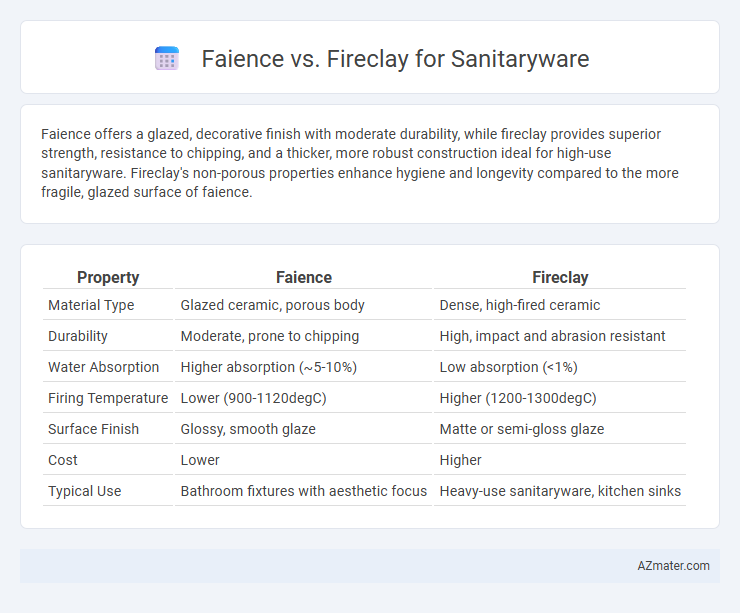Faience offers a glazed, decorative finish with moderate durability, while fireclay provides superior strength, resistance to chipping, and a thicker, more robust construction ideal for high-use sanitaryware. Fireclay's non-porous properties enhance hygiene and longevity compared to the more fragile, glazed surface of faience.
Table of Comparison
| Property | Faience | Fireclay |
|---|---|---|
| Material Type | Glazed ceramic, porous body | Dense, high-fired ceramic |
| Durability | Moderate, prone to chipping | High, impact and abrasion resistant |
| Water Absorption | Higher absorption (~5-10%) | Low absorption (<1%) |
| Firing Temperature | Lower (900-1120degC) | Higher (1200-1300degC) |
| Surface Finish | Glossy, smooth glaze | Matte or semi-gloss glaze |
| Cost | Lower | Higher |
| Typical Use | Bathroom fixtures with aesthetic focus | Heavy-use sanitaryware, kitchen sinks |
Introduction to Faience and Fireclay
Faience is a glazed ceramic material known for its smooth, glossy surface and is commonly used in sanitaryware due to its aesthetic appeal and ease of cleaning. Fireclay, on the other hand, is a dense, durable ceramic made from refractory clay, offering exceptional resistance to thermal shock and mechanical wear, making it ideal for heavy-duty sanitary fixtures. Both materials provide distinct advantages in bathroom applications, with faience emphasizing decorative finishes and fireclay delivering robust performance and longevity.
What is Faience? Key Properties
Faience is a type of glazed ceramic material characterized by its porous body coated with an opaque tin glaze, enhancing water resistance and decorative appeal. Key properties include its lightweight nature, vibrant enamel finish, and moderate durability, making it suitable for artistic sanitaryware applications but less resistant to mechanical stress compared to fireclay. Its non-porous glazed surface ensures hygiene and ease of cleaning, crucial for bathroom fixtures.
What is Fireclay? Key Properties
Fireclay is a highly durable ceramic material made from refractory clays, known for its exceptional resistance to high temperatures and chemical corrosion. Its key properties include high thermal shock resistance, outstanding hardness, and excellent durability, making it ideal for sanitaryware such as sinks and basins that require long-lasting performance. Fireclay sanitaryware is non-porous, stain-resistant, and maintains a smooth, glossy finish even under heavy use.
Comparison of Durability: Faience vs Fireclay
Fireclay sanitaryware exhibits superior durability compared to faience due to its dense, vitreous composition and higher firing temperatures, which enhance resistance to cracks, chips, and thermal shock. Faience, being more porous and less vitrified, tends to absorb moisture and is more susceptible to surface wear and staining over time. Fireclay's robust structure makes it ideal for high-traffic bathrooms, offering long-lasting performance and maintaining its aesthetic appeal under heavy use.
Water Absorption and Porosity Differences
Faience sanitaryware typically exhibits higher water absorption rates ranging from 5% to 15%, due to its more porous structure compared to fireclay, which has water absorption below 1%. Fireclay's dense composition results in significantly lower porosity, enhancing durability and resistance to staining and moisture penetration. These differences make fireclay a preferred choice for sanitaryware applications demanding superior longevity and hygienic performance.
Aesthetic Variations: Color, Texture, and Finish
Faience sanitaryware typically offers a glossy, smooth finish with vibrant color options due to its tin-glazed earthenware composition, enhancing aesthetic appeal for classic and decorative bathrooms. Fireclay sanitaryware, crafted from refined clay fired at high temperatures, presents a more matte or satin finish with subtle, natural tones and textures, favored for modern, minimalist designs. The color depth and surface texture differences between faience and fireclay influence their visual impact, with faience providing brighter hues and fireclay delivering earthy, understated elegance.
Manufacturing Processes: Faience vs Fireclay
Faience sanitaryware is manufactured through a process involving the firing of a fine, porous clay body at lower temperatures (around 1000-1100degC), resulting in a smooth, glazed finish but less durability. Fireclay sanitaryware undergoes firing at much higher temperatures (approximately 1200-1300degC), which vitrifies the clay, producing a denser, harder, and more heat-resistant material ideal for heavy-duty applications. The key manufacturing difference lies in the firing temperature and clay composition, with fireclay offering superior mechanical strength and resistance due to its high-temperature vitrification process.
Cost Analysis and Market Availability
Faience sanitaryware typically offers a lower cost option due to its glazed earthenware composition, making it suitable for budget-conscious projects, while fireclay sanitaryware, made from fired clay at higher temperatures, commands a premium price reflecting its durability and resistance to chipping. Market availability for faience is widespread, supported by numerous manufacturers catering to mass-market demand, whereas fireclay products are less common, often sourced from specialized suppliers targeting luxury and high-end segments. Cost analysis reveals faience's competitive pricing benefits for large-scale installations, but fireclay's longer lifespan and minimal maintenance can yield better long-term value despite initial higher investment.
Suitability for Different Sanitaryware Applications
Faience offers a glossy, decorative finish ideal for bathroom fixtures like sinks and washbasins where aesthetic appeal and smooth surfaces are prioritized. Fireclay, with its exceptional durability and resistance to high temperatures, suits heavy-use applications such as toilets and bathtubs that require robustness and long-term wear resistance. Choosing between faience and fireclay depends on the balance between decorative appeal and functional durability needed for specific sanitaryware installations.
Which is Better? Choosing Between Faience and Fireclay
Fireclay offers superior durability and resistance to chipping compared to faience, making it ideal for sanitaryware like sinks and basins subjected to heavy use. Faience, characterized by a glazed ceramic surface, provides a smooth, decorative finish but tends to be more fragile and less resistant to impact. For long-term performance and robustness in sanitaryware applications, fireclay is generally the better choice due to its strength and resistance to thermal stress.

Infographic: Faience vs Fireclay for Sanitaryware
 azmater.com
azmater.com